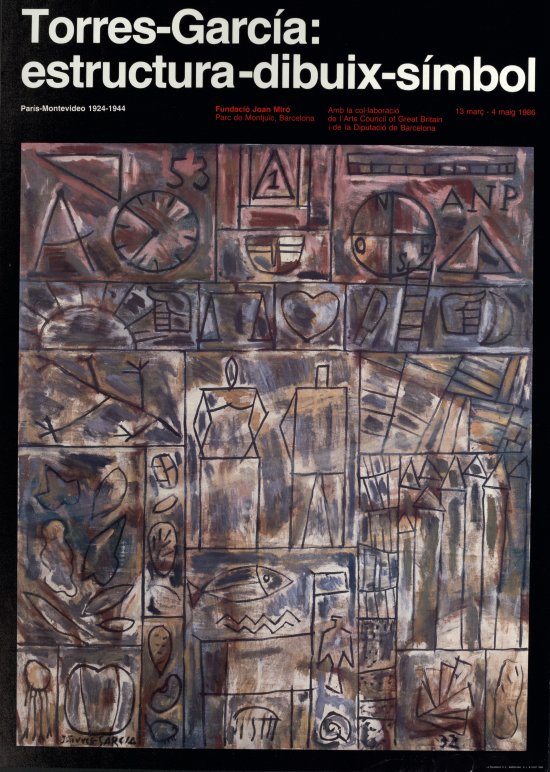- Dates
- —
- Curated by
- Margit Rowell
Torres García: Structure-Drawing-Symbol. Paris-Montevideo: 1924-1944
Joaquín Torres-García was born in Montevideo, Uruguay, in 1874. His family moved to Barcelona in 1892, and there he painted according to Noucentista trends. He lived in Barcelona until 1920, then in New York, Italy and the South of France, before settling in Paris in 1926.
In Paris, he discovered the most avant-garde artistic movements of the time and reformulated his pictorial style. Initially inspired by the geometric abstraction of Mondrian and Van Doesburg, around 1929 he began to organise his landscapes and still lifes according to a grid structure based on the golden section (nos. 19, 22). He also experimented with wooden constructions based on the same principles (nos. 13-15, 23-28). But although the golden section expresses a universal harmony, Torres-García felt that it was not enough to translate his vision of the world. He needed a more human element, which he found specifically in the signs and symbols he placed in the grid, representing elements of the physical, intellectual and emotional worlds. This characteristic pictorial style that he developed in this manner reached its peak between 1930 and 1932 (nos. 30-32, 42).
Ironically, it was also in Paris, in 1930-1931, that Torres-García became aware of his South American heritage and of Indo-American visual traditions. The stylisation and, above all, the spirituality, timelessness and enduring meaning he found in North and South American Indian artefacts attracted him in his quest for a universal pictorial language. He frequently visited the Trocadéro Ethnographic Museum (now the Musée de l’Homme). His latticework structures gradually became more irregular and dynamic, recalling the Inca masonry of Peru; his palette became coarser; his drawings, influenced by the pre-Columbian Nazca ceramics, became more abstract; and his signs and symbols were more Amerindian in inspiration.
In 1932, Torres-García moved with his family to Madrid, where he became acquainted with the great prehistoric and American collections of the Ethnographic Museum. These collections increased his interest in primitive and archaic civilisations and inspired his paintings of 1933 and later, in which stylised figures fill the frame (nos. 63, 64). In these paintings, structure, colour and symbol are combined in a single abstract drawing, conveying a sense of powerful primitive magic.
When he returned to Montevideo in 1934, he continued to develop the structure and iconography of his paintings according to pictorial principles of similar origin. During the first few years after his return, he painted little (although he drew a lot). Between 1935 and 1938, apart from a few paintings in his characteristic style, he produced a series of monochrome canvases in which he eliminated pictograms and transformed the grid structure into an architectural arrangement of tubular forms (nos. 71, 72, 75, 76). When animal or anthropomorphic figures appear, they are more slender, graphic and animistic in terms of feeling, recalling the rigorous stylisation and timeless spirituality of the pre-Columbian artefacts and idols he admired (nos. 79, 82, 84).
Torres-García also devoted himself to teaching in Montevideo. He set up an art school, worked as a lecturer, published a number of magazines and books on artistic theory and generally encouraged his fellow citizens to develop their own local school and style. His studio (the Taller Torres-García) and his mastery are renowned throughout South America.
Although Torres-García died in Montevideo in 1949, his influence can still be felt today.
Torres-García’s mature style can be described as a mix of a sophisticated European language (geometric abstraction) with the spirituality and energy found in the stylised images and drawings of abstract visual conventions. His art has always been difficult to categorise because of this. Nonetheless, this unique synthesis of classicism and primitivism is his contribution to 20th century art.
Margit Rowell


